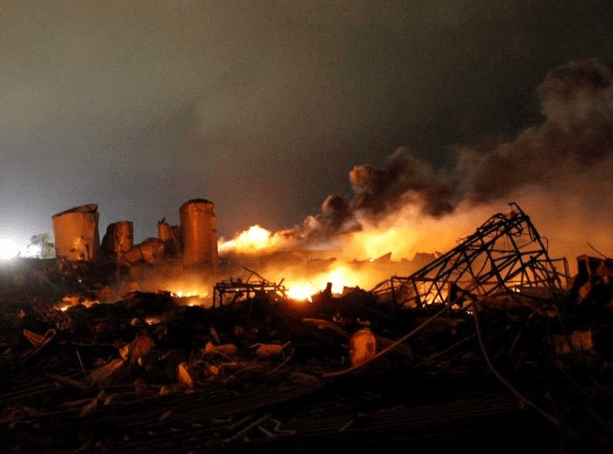The article below originally ran on April 18, 2013, one day after a massive explosion at a fertilizer plant in West, Texas destroyed the facility and caused 15 fatalities (mostly first responders) and millions of dollars in property damage. We are reposting the article on this, the two-year anniversary of the event.

The aftermath of an explosion at a fertilizer plant in West, Texas, April 17, 2013. (Photo via BusinessInsider.com)
At the time of this writing, the campus of Baylor University is quiet, subdued under a twin burden thanks to the dismal weather (due to a cold front/rainstorm combo) and an event that occurred just twenty short miles up the road in West. As reports roll in documenting the destruction – physical, emotional, communal – wrought by an explosion at a fertilizer plant on the north side of town, the Baylor community is responding with a prayer vigil, offers of donations of materials and financial gifts, and the use of our collective expertise in helping the citizens of West find new hope in the rubble of last night’s wreckage.
As we try to come to grips with the scope of devastation, it comes at a time when the national mood is already unsettled due to the bombings at the Boston Marathon on Monday. Add into the mix the fact that this, the third week in April, has seen traumatic national events in the past two decades (the Columbine High School massacre, the Oklahoma City bombing and the Branch Davidian standoff, chiefly) and you have a general sense of discomfort, a time of unwanted reflection on the darker side of human nature.
All of this may seen like a strange topic for a blog post focused on digital collections, but it reinforces an absolutely inarguable point: life is uncertain. We can build legal structures, steel-studded concrete walls, social norms and inner rationalizations to protect us from the things beyond our control, but they can only take us so far. For all of us will face an event in our lives that we cannot control, that is beyond our power to influence. And in the midst of that uncertainty, it helps to have reminders that our daily work to preserve the documented history of our campus, our community, our world is one way we can provide the tumultuous present with a concrete anchor to the past.
“The Preservers of History”
Chiseled into the stonework of the façade of Pat Neff Hall, Baylor’s main administration building, is a quote from former Baylor president (and two-term Texas governor) Pat Morris Neff. It reads, “The preservers of history are as heroic as its makers,” and I believe this sums up our role in the Digital Projects Group in a simple, profound way that paragraphs of explanatory text cannot. We are the preservers of history, yes, by the nature of our work to digitize physical history and preserve its digital surrogate for access by the future. But more important than simply scanning and archiving data, we are preserving the stories contained within those documents and we are ensuring that those stories will be accessible and available to people many years from now. On days like today, it seems particularly important to preserve the stories happening all around us, even if they aren’t as newsworthy as an explosion, a natural disaster, or a terrorist attack.
This is not a responsibility we take lightly, of course. For every artifact, archival resource, photograph, map or other item that comes through our doors, we know we are handling the “real stuff” of history and it is our job to take that one unique thing and give it a new life, a greater usefulness in the realm of academic scholarship and worldwide access. In a sense, we serve not so much as the preservers of history but as its spokesmen, the professional communicators tasked with taking something out of its phase box, Mylar sleeve or acid-free folder and putting it on an international stage via the Internet so its unique story can reach people on our campus, on our continent, on the other side of the world.
The Way of All Flesh (and Data)
We are given only a short time on this Earth to do the work we were created to do. There will come a time when the words of this blog will be seen as a record of what one group of people thought was important in the early decades of the 21st century. They will read of a fertilizer plant explosion in a small, Czech community in central Texas and want to know more about how it spurred a library staff member at Baylor University to write about its relation to digital preservation.
To those future researchers –and to my 2013 contemporaries reading this post today – I can only say that as this week’s unexpected events have unfolded on the East coast and a half-hour drive from my front door, it drives home to me the frailty of life, the knowledge that the things we create today are not promised to exist tomorrow, and that the challenge for our field is to try to find some permanence in the world, to promise our grandchildren’s grandchildren that they will have access to the world we are living in today. And, more importantly than all of this, that they will have access to our stories.
If you would like to assist the people of West in their recovery and rebuilding efforts, please visit Baylor’s “Response for the City of West” web age or contact the Central Texas Red Cross. Photo from REUTERS photographer Mike Stone via Business Insider (www.businessinsider.com)
